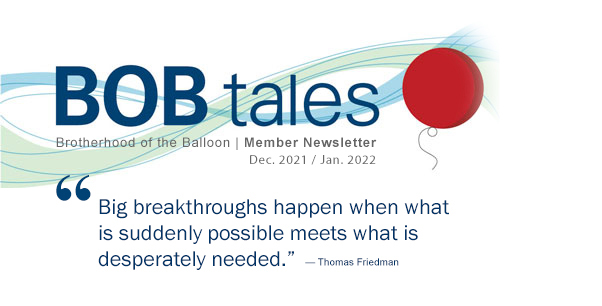
Dear Members (a note from Deb Hickey):
As the holiday season and winter are upon us – somewhat marred by the ever-present coronavirus, we find ourselves caught up in the typical string of events – shopping, cooking, decorating, and planning or attending gatherings.
It’s not easy to forget the previous year as we find ourselves staring at a calendar that says 2022. Our schedules are overbooked; obligations pile up; and if you’re anything like me, you find yourself getting overscheduled, frustrated, and exhausted.
Remember the oxygen mask rule – “Please place the mask over your own mouth and nose before assisting others.” Managing your self-care is key to maintaining happiness, physical health, and mental health. In my case, it requires consciously planning time in my day to attend to my own needs and make me a priority. How can you care for others if you don’t first take care of yourself? Impossible.
So, at this time of year especially, try not to let yourself get lost in the shuffle!
----------------------------
This is another comprehensive issue of BOB Tales, so get comfortable …
This month we share a truly amazing story of a man who traveled to Germany to literally “erase” his metastatic prostate cancer. We’ve already told you about the groundbreaking treatment he received in a previous issue, and we now have more information to share. We also follow up on a story we reported on last summer – a blood test that can detect 50 types of cancer!
The largest-ever study on military aviation and cancer has uncovered some eyebrow-raising facts about fighter pilots and prostate cancer. We’ll tell you why this report really hit home.
There’s a group of genitourinary oncology experts that has finally gone on record to share the body of academic research which supports the efficacy of proton therapy for prostate cancer. That’s bad news for those health insurance companies who often use the term, “experimental” or “investigational” as a reason to deny coverage.
We link to a recent interview with a radiation oncologist from the Maryland Proton Treatment Center who talks about the benefits of using proton therapy for pancreatic cancer as well as an exciting clinical trial using hyperthermia!
This month we pause to remember a remarkable human being, one who volunteered his time and expertise in so many ways to support the proton therapy movement and our organization.
We also explain our reasoning behind our “Giving Back” section. And of course, there’s much more.
Before I end my introductory letter, I’d like to sincerely thank all of you who’ve made contributions to the Robert J. Marckini Endowed Chair for Proton Therapy Research at Loma Linda this year – and those of you who have placed LLUCC in your estate plans as my father and I have done. Your generosity will impact the lives of thousands of men, women, and children. The Brotherhood of the Balloon is truly a brotherhood of special, caring, and giving people.
----------------------------
We hope you enjoy the BOB Tales. And as always, we welcome and encourage your feedback. Please send an email to [email protected].
Deb Hickey
To print the BOB Tales newsletter or view the newsletter with a larger font size, click here for the PDF file. .jpg)
.jpg)
In This Issue:
- New Hope in the Fight Against Metastatic Prostate Cancer
- Blood Test Finds 50 Types of Cancer
- Fighter Pilots at Greater Risk of Certain Cancers
- Proton Therapy No Longer ‘Experimental’
- Proton Therapy and Pancreatic Cancer
- In Case You Had Any Doubts About Your Proton Decision
- Mediterranean Diet Warning
- Eating Walnuts Can Lower Cholesterol, Reduce Risk for Heart Disease
- Lower Risk of Lethal Prostate Cancer Comes with This Diet Change
- Three New Studies Address How Plant-based Diets Impact Men’s Health

.jpg)
New Hope in the Fight Against Metastatic Prostate Cancer
We reported on an incredible breakthrough technology called theranostics back in May. Theranostics combines molecular therapies (therapy) and paired molecular targeted imaging (diagnostics). In theranostics, a special diagnostic molecule is first used to find the cancer. That same molecule is then modified and used to go back in and destroy the cancer.
While Loma Linda University Health (LLUH) is collaborating with BAMF Health to establish a theranostics center, the therapy is already being practiced in Germany and the results are extraordinary.
More than 100 Metastases
"They were literally speckled throughout my body, in my bones," said 64-year-old sales manager, Alan Held. Doctors told Alan he had stage-four prostate cancer and it had spread throughout his body.
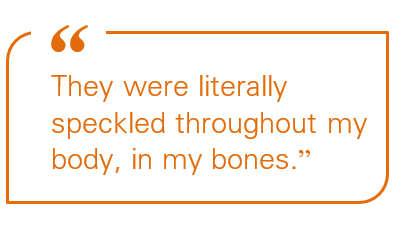 Alan started hormone therapy in September 2018. Seven months later, his cancer was still in his bones.
Alan started hormone therapy in September 2018. Seven months later, his cancer was still in his bones.
Fortunately, Alan’s son, Josh, had been doing some online research that led him to theranostics. Despite the fact that the treatment was offered only in Germany and the Helds lived in California, they decided they had little to lose.
On Alan’s first day of treatment at the Theranostics Center for Molecular Radiotherapy and Molecular Imaging in the town of Bad Berka, doctors put an IV in his arm for 30 minutes, sending molecular-targeted liquid radiation on a search-and-destroy mission.
Astonishing Results
A follow-up scan showed that 80 percent of the metastases in Alan’s body had disappeared.
Alan returned to Germany for a second round of treatment three months later, and again a few months after that. “It just kept erasing the cancer,” Alan said.
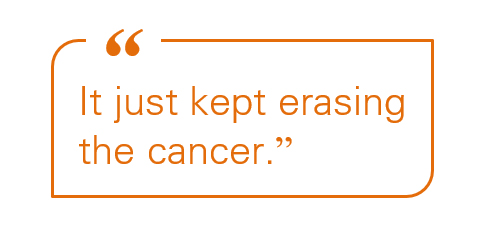 Today, nearly two years later, Alan has only three small dormant spots in his body. He thanks God, the clinic in Germany, and Dr. Frankis Almaguel from Loma Linda University Health.
Today, nearly two years later, Alan has only three small dormant spots in his body. He thanks God, the clinic in Germany, and Dr. Frankis Almaguel from Loma Linda University Health.
The Loma Linda Connection
As we mentioned in our May BOB Tales, Dr. Frankis Almaguel is the Director of the Molecular Imaging and Therapeutics Research Program at Loma Linda University Cancer Center. He was there at the clinic for training in Germany the day Alan arrived.
“He walked up to me and said, ‘Are you Alan from California? I’m Frankis from Loma Linda. I’m on this ride with you, my brother,’” said Alan.
Dr. Almaguel explained to Alan that he’d been working to bring theranostics to the Loma Linda University Cancer Center. In fact, “Phase 0” in the development of the theranostics center involves diagnosing the patient, determinging if they’re a candidate, and following them to and through treatment in Germany where theranostics has been ongoing for more than a decade. When Dr. Almaguel met Alan that day, he was waiting on some LLUCC patients who were flying in.
The Details: Search and Destroy
A prostate specific cancer marker molecule is labeled with a radio isotope and injected into the patient. The molecules seek out tumors, bind to them, image them, and then light them up so doctors can see exactly where the cancer is.
"Then we change the radio isotope from diagnostic to therapeutic,” said Dr. Almaguel. “Since the liquid radiation only goes to cancer cells, we can destroy cancer and spare normal cells.”
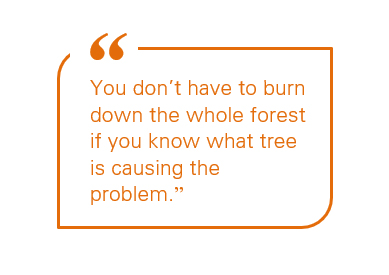 Not only is this pretty amazing technology, it’s also very different than other cancer treatments, which are largely trial and error. For example, once a patient is given chemotherapy, they must wait months to see if it worked. Furthermore, chemotherapy kills a wide range of cells, not just cancer cells. “You don’t have to burn down the whole forest if you know what tree is causing the problem,” said Dr. Almaguel.
Not only is this pretty amazing technology, it’s also very different than other cancer treatments, which are largely trial and error. For example, once a patient is given chemotherapy, they must wait months to see if it worked. Furthermore, chemotherapy kills a wide range of cells, not just cancer cells. “You don’t have to burn down the whole forest if you know what tree is causing the problem,” said Dr. Almaguel.
And It Gets Better
Because theranostics is so precise, there are fewer side effects. Alan Held said he had none.
LLUCC, in collaboration with BAMF, already has a “phase 0” theranostics clinic where they’re able to diagnose patients and facilitate their treatment in Germany. They’re currently designing and building a “phase 1” clinic, which will allow for treatment in the U.S. This will also require the FDA approval of the drug, which they hope will come by early 2022. Future development (timeline is two years) will bring “phase 2,” a full theranostics center.
Alan Held had hundreds of metastases, including a large tumor on his spine. His doctors told him to lie low and do nothing more than walk. Eight months after theranostics, Alan was skiing at Lake Tahoe.
.jpg)
.jpg)
Blood Test Finds 50 Types of Cancer
We reported in our August BOB Tales about this test that was invented by Grail, a biotechnology company in Menlo Park, CA. Mayo Clinic has partnered with Grail in the development of the test, which is known as “Galleri.” This new test looks for signals in the blood stream that are associated with specific cancers. Cancer-specific information is carried in bloodstream DNA. According to a recent article in Health Care, “The Galleri test uses next generation sequencing and machine-learning algorithms to analyze methylation patterns of cell-free DNA,” which helps identify specific cancers. Cells regulate gene expression using DNA methylation. The Galleri test can also pinpoint the location of the disease allowing doctors to select appropriate treatments to target and destroy the cancer.
Having access to a single blood test that can detect 50 types of cancer is significant. The Health Care report states, “Currently recommended cancer screenings in the U.S. cover only five types of cancer and can screen for only one type at a time.” Yet, 71 percent of cancer deaths are caused by cancers that are not commonly screened for, according to Grail. False positives with the Galleri test are low, according to researchers, at about one in 200 people tested.
The test is recommended for adults, typically over 50 with an elevated risk for cancer. It should not be a substitute for currently approved tests, such as colonoscopies or mammograms.
Galleri and Mayo Clinic have not received FDA approval for this new test, and insurers do not cover the $949 cost. This blood test is, however, available to the general public and must be administered by a licensed health care provider.
FDA approval for this breakthrough blood test is expected soon and we will report here when that happens.
.jpg)
.jpg)
Fighter Pilots at Greater Risk of Certain Cancers
We’ve often thought that we seem to have a disproportionate number of pilots in our prostate cancer group relative to the general population. Perhaps there’s a reason for this.
 A recent article in MilitaryTimes reports, “Nearly 35,000 active-duty airmen who flew on fighter jets between 1970 and 2004 are at higher risk of developing prostate cancer and melanoma, with possible links to non-Hodgkin’s lymphoma and testicular cancer as well, according to the largest-ever study on military aviation and cancer.” Men who flew fighter jets during those time periods would likely be between 40 and 80 years old today, which happens to be precisely the age range of the BOB group.
A recent article in MilitaryTimes reports, “Nearly 35,000 active-duty airmen who flew on fighter jets between 1970 and 2004 are at higher risk of developing prostate cancer and melanoma, with possible links to non-Hodgkin’s lymphoma and testicular cancer as well, according to the largest-ever study on military aviation and cancer.” Men who flew fighter jets during those time periods would likely be between 40 and 80 years old today, which happens to be precisely the age range of the BOB group.
The study was launched in 2020 and it focused on finding links between fighter pilots and 10 types of cancer, including colorectal, pancreatic, melanoma, prostate, testicular, bladder, kidney and renal-pelvis, thyroid, brain, and other nervous system cancers plus non-Hodgkin’s lymphoma. Most attention was paid to the years 1965 to 1973 during the Vietnam War and four specific aircraft: the F-100 Super Sabre, the F-105 Thunderchief, the F-4 Phantom II and the RF-4 variant used for reconnaissance.
The pilots and backseat crews were mostly white men. Black airmen represented 17 percent of the group. And, women, back then, represented less than 1 percent of the aviators.
Compared to the general population, the men studied were 20 percent more likely to develop prostate cancer, 25 percent more likely to have melanoma and 13 percent more likely to have non-Hodgkin’s lymphoma. Pilots and weapons system officers on any fighter platform were 30 percent more likely to have testicular cancer and 25 percent more likely to have melanoma and prostate cancer.
Men who flew the F-100, the first jet capable of flying faster than the speed of sound had the highest cancer incidence, according to the study. “Compared to fighter aviators who never flew the F-100 . . . male fighter aviators who flew the F-100 had greater odds of being diagnosed and dying from colon and rectum cancer, pancreatic cancer, melanoma skin cancer, prostate cancer and brain cancer.” . . . “They also had greater odds of dying from thyroid cancer and non-Hodgkin’s lymphoma.”
Despite other studies on Agent Orange, this study could not prove a definitive link between this carcinogenic herbicide and cancer in Super Sabre aviators, even though these aircraft regularly provided overhead cover during missions to spray Agent Orange.
The report suggests that “airmen prioritize sunscreen and wear clothes that protect from the sun, take vitamin D supplements and get checked for skin spots that are changing shape or color. Prostate cancer prevention calls for a healthful diet, minimal alcohol and plenty of sleep, plus starting to screen for the illness earlier in life.”
It’s still unclear what is causing the differences in cancer diagnoses between airman in the fighter field and others in the military. And it doesn’t look like any changes are planned following this study. The article concludes with the following: “While the research offers some clues about possible cancer prevention measures, it’s not enough to warrant broad policy changes for the Air Force fighter community,” according to the Air Force’s School of Aerospace Medicine at Wright-Patterson Air Force Base, Ohio.
.jpg)
.jpg)
Proton Therapy No Longer ‘Experimental’
Based on the analysis of decades of data on proton therapy, a new consensus statement from the Particle Therapy Co-Operative Group (PTCOG) illustrates why it should no longer be considered “experimental” treatment for prostate cancer.
This report is significant because it’s the first time a group of genitourinary oncology experts have gone on record to share the body of academic research that supports the efficacy of proton therapy for prostate cancer.
Those private insurers who still use “experimental” as a reason to deny patients coverage may want to sit up and listen. According to researchers, it’s no longer accurate to refer to proton therapy as investigational for a condition we all know it treats highly successfully.
But Can Proton Deliver Better Results?
The question is, can proton therapy deliver better results than conventional radiotherapy? Although randomized evidence in other disease sites reports a benefit to bowel function and reduction in toxicities with proton therapy, more dedicated and detailed studies are required to make definitive claims about superior efficacy – especially when it comes to prostate cancer.
Thankfully, the COMPPARE study, led by Nancy Mendenhall, MD, Professor, Dept. of Radiation Oncology and Medical Director, University of Florida Health Proton Therapy Institute, and conducted in partnership with about 100 cancer centers across the country, should answer the question, once and for all, as to whether or not there are discernible differences between proton therapy and IMRT in treating prostate cancer. Results of the study could resolve disagreements that are restricting patients’ access to proton therapy, particularly with regard to private medical insurers’ coverage and reimbursement policies. Initial data from the COMPPARE will be reported in 2026.
The Good News
Proton therapy is getting less expensive as it can be delivered in fewer treatments than has historically been delivered with traditional radiation therapy. And as we reported last month, results from the CHHiP clinical trial show a shorter course of radiotherapy, administered through fewer, higher intensity doses, is as well tolerated over five years as longer treatment courses for treating men with prostate cancer.
Furthermore, the costs of building proton therapy centers has declined over time as the technology has gotten more compact – smaller particle accelerators, smaller facilities.
As the cost of proton therapy comes down and more studies show the benefits of proton over conventional photon therapy, the interest and demand for proton therapy will accelerate. Coupled with the explosive growth in the number of proton centers worldwide, patient access to proton therapy should improve greatly in the coming years.
In the meantime, it’s important to shine a light on the new PTCOG consensus statement (especially in your insurance appeal letters) to keep the momentum going in the direction
of furthering the role of proton therapy for cancer patients.
.jpg)
.jpg)
Proton Therapy and Pancreatic Cancer
In a recent interview, William F. Regine, executive director and radiation oncologist at the Maryland Proton Treatment Center, spoke about the benefits of using proton therapy in conjunction with other treatments for patients with pancreatic cancer.
“We can deliver full dose chemotherapy with protons,” he said. The combination gives patients a better chance of survival because proton therapy helps to shrink the tumor.
Additionally, Dr. Regine and his team are working on a pancreatic cancer clinical trial involving hyperthermia. This involves heating tumors to “fever temperature,” about 105 degrees.
Hyperthermia is applied as adjuvant to radiotherapy or chemotherapy and works to sensitize tumor cells. The heat causes blood vessels to dilate and improve flow, bringing more oxygen into the tumor and making cancer cells more vulnerable to radiation therapy.
In an earlier article, Dr. Zeljko Vujaskovic, professor of radiation oncology at the University of Maryland School of Medicine, said research suggests that using hyperthermia with proton therapy may be associated with an even greater benefit than when combined with standard radiation therapy. We’re not surprised.

We’ve been producing BOB Tales newsletters for more than 20 years. During this time there have been articles that many new members haven’t seen, and some older members may have forgotten. So, we periodically re-run articles from past newsletters. The following is from September 2006.
In Case You Have Any Doubts About Your Proton Decision
This is the sad story of a gentleman who had narrowed his choices to proton and robotic laparoscopic surgery. He chose the latter for cost and convenience, and now regrets it. Here is part of his email to us:
I had robotic surgery in May. I’m telling anyone who’s trying to decide between treatments, that if time away and a little more cost for lodging and transportation is not
an issue, go with proton therapy.
Most go home (from robotic laparoscopic treatment) the day after surgery. My blood pressure was 80/50 the next day, and I kept fainting when they tried to get me up. I couldn’t eat and had a distended stomach from the gas they used. The gas even formed a painful pocket in my shoulder!
I came home the third day, and they took the catheter out a week later. That evening, I had to have an ambulance take me to the ER with unbelievable pain in my abdomen. I had urine retention, bladder spasms, and a tear in my urethra/bladder reconnection. They had to reinsert the catheter and I went back for three cystograms before they took the catheter out a month after surgery.
There is a possibility I might need a second surgery to repair the tear. I am still mostly incontinent after three months, but I have started showing some improvement.
If I had it to do over again, I would choose proton therapy. The BOB member testimonials almost convinced me, but I needed my vacation time to see my new grandson in New York. I also estimated that it would cost an extra $2,000 for lodging and travel for proton treatment.
I’m sure my wonderful love life with my wife of 31 years will never be the same, as I am not close to recovery in that area. The bottom line looks good, however, since the cancer was contained, and they think they got it all.
BOB Comment: Most men who choose robotic laparoscopic surgery have good results. But the risk of complications is always there with surgery of any kind.
Certainly, not everyone comes through proton therapy unscathed, but in the grand scheme of things, we generally fare a whole lot better than those who choose the other options. Our heart goes out to this man. His story gives us more incentive to tell the world about non-invasive, precisely targeted proton therapy, and why we believe it’s the best option for treating localized prostate cancer.

Bob Marckini was recently asked to write an article for the COMPPARE Newsletter about Pat Greany. Pat served as a volunteer for the University of Florida Health Proton Therapy Institute for many years following his successful treatment in 2006. He was also a BOB member who supported our efforts in many ways. He became a friend to both Bob and Deb.
The following was written by Bob Marckini.
Remembering Pat Greany
Those of us who are committed to helping men with prostate cancer lost a true friend on Sept. 15, 2021.
I met Pat Greany at a prostate cancer conference several years ago. He loved spending time anyplace where he could learn more about prostate cancer and/or connect with newly diagnosed men who were investigating treatment options. Pat was an expert on the subject having been treated twice for the disease.
I quickly discovered that Pat was a fountain of knowledge on the prevention, diagnosis, and treatment of prostate cancer. We instantly became friends and began sharing what we knew, our personal experiences, and our interest in proton therapy for localized prostate cancer. Pat’s technical education/training and his inquiring mind made him a sponge for all things prostate cancer related, and a wonderful source of information on the latest developments in diagnostics and treatment.
Pat graduated from Fresno State College and obtained a PhD in Entomology at UC Riverside, where he was named an “Outstanding Graduate.” He also did several post doctorates at Harvard, Stanford and Penn. State. He began his career in research at what is now known as the Center for Medical, Agricultural and Veterinary Entomology. His accomplishments and publications in the biological control of insects were many. He served as President of the Florida Entomological Society and on numerous graduate student committees at the University of Florida.
An early patient at the University of Florida Health Proton Therapy Institute (UFHPTI), Pat became enamored with the technology and found himself counseling prospective patients, fund raising, and promoting proton therapy.
Pat was always willing to share his story and offer help to those diagnosed with prostate cancer. And, since I knew Pat was a wealth of information and a technical powerhouse, I frequently asked for his help reviewing and abstracting technical literature. He always agreed, regularly wrote articles for our BOB Tales newsletter, and subsequently made himself available to anyone who desired more information on the subjects he covered.
Others recognized Pat’s intelligence, technical expertise and willingness to step in wherever he could be helpful. This included the Prostate Cancer Research Institute (PCRI) where he provided counseling to men with advanced prostate cancer. He later became a Consumer Reviewer for the Prostate Cancer Research Program (PCRP), an organization dedicated to supporting research to eradicate prostate cancer, with a focus on innovative and groundbreaking research.
Pat’s strongest interest was in finding more accurate and less invasive diagnostic procedures and treatments that might improve results and eliminate side effects. Most recently, Pat’s interests were in targeted biopsies and focal treatments for prostate cancer, once again, with a focus on minimizing collateral damage to non-targeted tissues.
Any time Pat could be helpful, he would always make himself available. For example, he gave freely of his time and expertise to the COMPPARE clinical trial effort.
When I completed the second edition of my book last year, I sent a copy of the manuscript to Pat and asked if he would consider writing a brief commentary to be included in the introductory section. Before he finished reading it, he called and said he’d be honored to provide an endorsement. He then wrote one of the most sincere and compelling reviews of my book, for which I will always be grateful.
 Pat was a loving husband and avid reader. He loved nature, especially spending time at his cabin in the woods in North Carolina and fishing in the Gulf of Mexico. And he loved his precious dog, Mitzi, who was always at his side.
Pat was a loving husband and avid reader. He loved nature, especially spending time at his cabin in the woods in North Carolina and fishing in the Gulf of Mexico. And he loved his precious dog, Mitzi, who was always at his side.
I’ll remember Pat as a smart and energetic proponent and defender of what he believed in; an educated and articulate spokesman for proton therapy; an eternal optimist, even when his health was failing – attempting to share with others whatever he learned from his own experience that could benefit them; always willing to get involved and to help; always ready to do what’s right; and always a friend.
When I spoke recently with Pat’s lovely wife, Jo, I asked her, “How do you think Pat would like to be remembered?” Without hesitation, she said, “Pat would want to be remembered as a scientist and as a friend.”
.jpg)
.jpg)
Love Your Uro?
Did your urologist work with you to help you choose the prostate cancer treatment option that was right for you and not just the modality in which he specializes? Did your urologist respect your decision to be treated with proton therapy? Does your urologist understand the benefits of proton therapy?
We receive requests all the time from newly diagnosed men as well as members – even those who were treated years and years ago – who are looking for a good urologist, especially one who has some knowledge of proton therapy.
If you answered “yes” to any of the above questions, please share your urologist’s name with us. We’ll add his contact information to our list of “Member Recommended Urologists.”
Just send an email to [email protected]. Thank you!

Why Loma Linda?
It was when the late Dr. James Slater was in his residency program at medical school that he first noticed the discomfort experienced by his patients because of the imprecise targeting of the X-ray radiation beam. He believed in his heart that radiation could be delivered more precisely. A fellowship took him to MD Anderson. There, he became interested in heavy-charged particle therapy.
Dr. Slater later set up a team to help him achieve an almost impossible goal: To bring proton therapy to a hospital setting. This culminated with the opening of the first hospital-based proton treatment center in the world at Loma Linda University Cancer Center in 1990. Since that time more than tens of thousands of patients have been treated with protons; most have been cured of their cancers and other diseases; and most have enjoyed excellent quality of life after treatment. Dr. James Slater’s son, Dr. Jerry Slater, who worked side-by-side with his father on the project, subsequently picked up the mantle, and for the past several years has led the Department of Radiation Medicine, as well as basic and clinical research efforts.
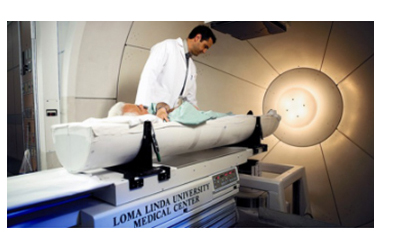 When Bob Marckini was treated for prostate cancer in 2000, LLUCC was the only proton center treating in the U.S. Today, because of the Slaters’ pioneering work, there are more than 40 proton centers in the U.S., dozens more around the world, and many more in the planning and construction stages.
When Bob Marckini was treated for prostate cancer in 2000, LLUCC was the only proton center treating in the U.S. Today, because of the Slaters’ pioneering work, there are more than 40 proton centers in the U.S., dozens more around the world, and many more in the planning and construction stages.
Please help us thank Dr. James Slater and Dr. Jerry Slater for their pioneering efforts and all they do to continually develop and improve proton therapy.
We charge no dues for membership in our group. Our members repeatedly tell us we provide considerable value to them through the various programs we have established over the years, beginning with Bob’s book(s) and including our website, former patient testimonials, 40-plus patient reference lists, medical insurance support, PowerPoint presentations, response to questions/emails/phone calls and especially our comprehensive monthly newsletters with timely information about new developments in prostate cancer prevention, detection, treatment, as well as the latest developments in proton therapy for treating prostate cancer and other diseases.
We don’t benefit from your gifts firsthand, but we are passionate about improving the use of proton therapy to benefit more people because we are dedicated to the advancement of this incredible technology. LLUCC is the institution that started it all. Without Dr. James M. Slater and his dream some 45 years ago, proton therapy would not be where it is today. We are the beneficiaries of Dr. Slater’s dream and legacy.
Your contributions help researchers who are studying new applications for the proton beam as well as physicians and scientists who are conducting clinical studies to determine better ways to use proton therapy to benefit more patients. Your gifts allow doctors to use proton technology to treat new cancer sites, new medical conditions, eliminate seizures in children, and help our war veterans.
There are numerous stories in the media about people who have had to leave their country to access proton therapy or set up funding programs to pay for proton treatment. Many struggle to gain access to proton therapy, while at the same time more and more insurance providers are cutting proton therapy from their coverage plans for cost reasons. Yet there is undeniable proof of the advantages of this precision form of treatment. Research programs and clinical trials need funding to bring the programs to completion, to lower the cost of treatment, and to prove, once and for all, that proton therapy is superior to other forms of radiotherapy.
Please help others have access to the treatment we’ve had the privilege of receiving. We urge you to consider: 1) Making a year-end gift to the Loma Linda University Cancer Center for proton research, and/or 2) Putting Loma Linda University Health in your estate plan. We have done this and many of our members tell us they have as well.
We are so grateful for your generosity.
.jpg)
.jpg)
Giving Options
- Donate to proton research online.
- Write a check to LLUCC Proton (Put “Marckini Chair” on the memo line) and mail to LLUH, Office of Philanthropy P.O. Box 2000, Loma Linda, CA 92354.
- Make an unrestricted gift (put “unrestricted” on memo line) so LLUH can use it where it’s needed most.
- Call Regina Joseph at 909-558-5010 to donate over the phone.
.jpg)
.jpg)
.jpg)
Don't Just Stand There
In an effort to boost funding for basic and clinical proton therapy research on prostate cancer, pancreatic cancer, liver cancer, breast cancer, and more, we asked our members to donate $100 (or more) to Loma Linda University Cancer Center. In return, they’d receive an advance copy of Dr. William Preston’s book, Don’t Just Stand There – Realizing a Vision for Proton Therapy: Conversations with James M. Slater, MD, FACR. The response so far has been phenomenal. Thank you to all who’ve requested a copy.
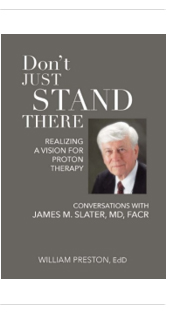 If you’d like a pre-published copy of “Don’t Just Stand There,” please send a check for $100 or more, payable to “Loma Linda University Proton Cancer Research” and mail it to:
If you’d like a pre-published copy of “Don’t Just Stand There,” please send a check for $100 or more, payable to “Loma Linda University Proton Cancer Research” and mail it to:
Loma Linda University Health ● Office of Philanthropy ● PO Box 2000 ● Loma Linda, CA 92354
Please notify Deb Hickey at [email protected] that you’ve sent in your check and your book will be mailed immediately.
Don’t Just Stand There, which contains high-quality color images and illustrations, is not only about Dr. Slater’s quest to create the world’s first hospital-based proton treatment center, it’s also a teaching guide. As the Proton Treatment & Research Center at Loma Linda was such an immense endeavor, Dr. Slater wondered if the aspects of conceiving, planning, and orchestrating such a project, among others he undertook, might be instructive to others. Over the years, he’d also met people in all walks of life, many of whom had dealt with large and complex problems. He was struck by some of the stories they told about their work. And although the fields or disciplines usually had nothing to do with medicine, many experiences were similar. And so, he kept this in mind while he worked on the book with Dr. Preston.
We’re sure you’ll thoroughly enjoy the book and we know it will occupy a place of honor
in your home. And, you’ll be helping to fund basic and clinical proton research on prostate cancer, pancreatic cancer, liver cancer, breast cancer, and much more with your tax-deductible gift. Thank you!

Mediterranean Diet Warning
The Mediterranean diet is rich in flavorful ingredients like fruits, vegetables, whole grains, nuts, olive oil, and fish. It has long been associated with a variety of health benefits including helping to support brain function, promoting heart health, regulating blood sugar levels, and more.
However, a new report suggests that if you’re not going organic, you could be doing more harm than good to your body. In fact, according to British scientists, consuming fruits, vegetables, and whole grains that are derived from traditional farming tecnniques could triple your intake of environmental contaminants. This can weaken the immune system, cause fertility issues, and even stunt the growth and development of children.
Because this was a small study, it’s too early for health officials to recommend against the Mediterranean diet. However, according to Health Sciences Professor Chris Seal at Newcastle University, “This study provides clear evidence that both our diet and the way we produce food may affect the level of exposure to synthetic chemical pesticides and ultimately our health.”
.jpg)
.jpg)
Eating Walnuts Can Lower Cholesterol, Reduce Risk for Heart Disease
 While all varieties of nuts contain important nutrients, walnuts may be especially good for protecting cardiovascular health, according to a recent study published in Circulation, an American Heart Association Journal. According to researchers from Loma Linda University and the Lipid Clinic at the University of Barcelona in Spain, eating a daily handful of walnuts can lower LDL cholesterol and total cholesterol, which is associated with a lower risk of cardiovascular disease (CVD).
While all varieties of nuts contain important nutrients, walnuts may be especially good for protecting cardiovascular health, according to a recent study published in Circulation, an American Heart Association Journal. According to researchers from Loma Linda University and the Lipid Clinic at the University of Barcelona in Spain, eating a daily handful of walnuts can lower LDL cholesterol and total cholesterol, which is associated with a lower risk of cardiovascular disease (CVD).
Researchers looked at lipid changes in nearly 700 healthy seniors in Barcelona, Spain, and Loma Linda, CA over the course of two years.
“Walnuts have a unique profile compared to other nuts,” said Sujatha Rajaram, PhD, professor of nutrition at Loma Linda University School of Public Health. “The omega-3 fat, fiber and a lot of vital nutrients make up the good stuff that works together to create a healthy package. Regardless of one’s diet, if you add walnuts, you will see some benefits — it’s going to be heart-friendly.”
.jpg)
.jpg)
Lower Risk of Lethal Prostate Cancer Comes with This Diet Change
A new study from the Cleveland Clinic shows there’s a connection between diet, the gut microbiome, and lethal prostate cancer. Researchers analyzed men between the ages of 55 and 74, monitoring them for 13 years.They found that those with higher levels of certain diet-related molecules were more likely to develop aggressive prostate cancer.
The good news is, reducing meat consumption can help. “Generally, the metabolites associated with lethal prostate cancer are found to be enriched in meat and other animal products,” said Dr. Nima Sharifi, MD, and Director at Genitourinary Malignancies Research Center at the Cleveland Clinic Lerner Research Institute. “As we continue our research in this area, our hope is that one day these molecules can be used as early biomarkers of prostate cancer and help identify patients who can modify their disease risk by making dietary and lifestyle changes.”
.jpg)
.jpg)
Three New Studies Address How Plant-based Diets Impact Men’s Health
 Three new studies by University of Miami Miller School of Medicine urologists report on the impact a plant-based diet can have on a range of men’s health issues. And this doesn’t necessarily mean a diet without meat, rather a regimen that includes more whole grains, fruits, vegetables, nuts and legumes and less animal protein.
Three new studies by University of Miami Miller School of Medicine urologists report on the impact a plant-based diet can have on a range of men’s health issues. And this doesn’t necessarily mean a diet without meat, rather a regimen that includes more whole grains, fruits, vegetables, nuts and legumes and less animal protein.
Plant-based Eating and PSA
Urology resident Ali Mouzannar, M.D. and her colleagues studied the dietary habits of nearly 1,400 men. They found those who consumed more fruits, vegetables, and other healthy plant-based foods, and less meat, had lower PSA levels than men who consumed more meat or less healthy diets.
“Studies have shown that more aggressive prostate cancer can be associated with high meat intake. In addition, there is growing evidence that animal-based food has been associated with greenhouse emissions, and all-cause mortality risk.,” Dr. Mouzannar said. “Several other publications suggest that fruits and vegetables may have protective effect against prostate cancer.”
More studies need to be conducted to determine if diet causes lower PSA levels, but from these findings, it appears that “adopting a plant-based diet may be associated with lower PSA levels and can certainly be incorporated into ways that patients can live healthier lifestyles,” said Dr. Mark Gonzalgo MD, PhD, professor and vice chairman, Urology, Miller School.
No ED, Testosterone Links
Many men dismiss plant-based diets for fear that eating less meat might negatively impact testosterone levels and sexual health. However, Miller School investigators found no impact on testosterone levels from a healthy plant-based diet. And in fact, they found that plant-based diets are associated with decreased risk of erectile dysfunction.
“We are on the cusp of figuring out how healthy living with decreased animal protein and more of a plant-based diet with more vegetables and fruits is not just better for your heart but also good for men's health conditions, including sex life and testosterone levels,” said Dr. Ranjith Ramasamy, M.D., associate professor and director of the Miller School’s Reproductive Urology Program.

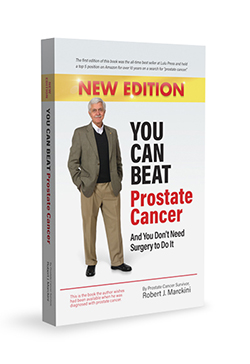 You Can Beat Prostate Cancer: And You Don’t Need Surgery to Do It – Second Edition
You Can Beat Prostate Cancer: And You Don’t Need Surgery to Do It – Second Edition
More and more proton centers are sending Bob’s book to prospective patients. And more and more of these prospective patients are choosing proton therapy after reading this book, which makes such a compelling case for the proton option.
Following is a recent Amazon review:

Thanks so much…
As a prostate cancer patient, I am truly grateful for this book and for the work that the author put into it. After digesting all the information therein, I’ve chosen proton radiation therapy.
In my ongoing prostate cancer-treatment research, this has been the most comprehensive body of information that I’ve encountered. The time and energy that was put into writing this book must have been humongous, and this has made me doubly grateful.
Step 3 in the 10 Steps
In October we began excerpting perhaps the most important section in Bob’s new book, Chapter 18, titled, “Ten Steps for Taking Control of the Detection and Treatment of Your Prostate Cancer.” Step 1 was “Choose Your Doctors Wisely;” Step 2, “Have a PSA Test and DRE as Part of Your Annual Physical, And Track the Results.” Following is Step 3:
Have Multi-parametric MRI Imaging if PSA is Rising
I covered this subject quite extensively in Chapter 17 when discussing new diagnostic tools and the evolution of prostate cancer testing and detection.
With today’s technology, I can’t imagine jumping to the invasive and uncomfortable biopsy step without doing a multiparametric MRI – preferably 3-Tesla – to determine if there are any suspicious areas within my prostate and also knowing my PIRADS assessment.
If you have rising PSA, suggesting the possibility of prostate cancer activity, it would be to your great advantage to find a medical center that can perform a 3-Tesla multi-parametric MRI of your prostate. This could tell you a) if there are any suspicious lesions present, and b) if a prostate biopsy is needed at all.
By using mp-MRI imaging you have a significantly greater chance of finding cancer if it’s there and providing important information that can be used if a biopsy is ordered.
.jpg)
.jpg)
Did you find Bob’s new book helpful?
Please write a review on Amazon.
We’re happy to discount books in quantity (minimum 20) to anyone interested in spreading the word on proton therapy. Just send an email to Deb Hickey. Proceeds from book sales are used to help fund our efforts and to support proton therapy research.
The Kindle version is free to Kindle Unlimited members or can be purchased for $9.99 for non-members. The paperback price is $22.45. Buy You Can Beat Prostate Cancer second edition on Amazon or Lulu Press.

National Proton Conference
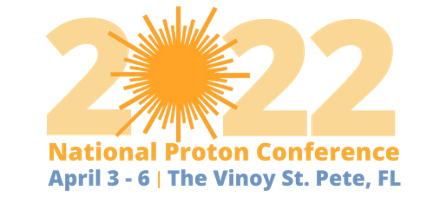 The National Association for Proton Therapy (NAPT) will be holding its next annual conference in St. Petersburg, FL, April 3-6, 2022. There will be two full days of in-person engagement, education, and collaboration among experts in the proton therapy world.
The National Association for Proton Therapy (NAPT) will be holding its next annual conference in St. Petersburg, FL, April 3-6, 2022. There will be two full days of in-person engagement, education, and collaboration among experts in the proton therapy world.
Exhibits: There are typically large halls filled with exhibits showing the latest developments in proton therapy technology, equipment, systems, and support systems. Information is presented on new particle accelerator design, new beam delivery systems, more precise control systems, and many things connected with proton therapy.
Attendance: Proton therapy centers from all over the world send representatives to the conference. Often clinicians and clinical leaders from all the major U.S. proton centers are in attendance, and many participate in panel discussions. Other attendees include physicists, senior administrative officials, and vendors who design and make equipment, products, and systems that support proton therapy and related technologies.
Panels and Presentations: Several presenters and panels will address a variety of proton-related issues ranging from the latest developments in proton therapy research, clinical and technological advances in proton therapy, global proton initiatives, and the economics and sustainability of proton center development and growth.



Last Month’s Brain Teaser
Among timepieces, sundials have the fewest moving parts. Which timepiece has the most moving parts?
Answer: An hourglass (it’s full of sand)
Winner: The brain teaser winner for November wishes to remain anonymous.
.jpg)
.jpg)
New Brain Teaser
You have three boxes, all sealed. The first is full of oranges, the second full of lemons, and the third full of a mixture of oranges and lemons. All three boxes are incorrectly labeled. You are allowed to pick a piece of fruit from one box only. How can you tell which box is which?
Send your brain teaser answer to [email protected] for a chance to win a signed copy of Bob Marckini’s NEW second edition book, You Can Beat Prostate Cancer.
.jpg)
.jpg)
Interesting Oxymorons
|
found missing open secret small crowd |
act naturally fully empty pretty ugly |
original copy only choice liquid gas |
.jpg)
.jpg)
Classy Insults (Source)
These glorious insults are from an era “before” the English language got boiled down to four-letter words.
“He had delusions of adequacy.” ─ Walter Kerr
“He has all the virtues I dislike and none of the vices I admire.” ─ Winston Churchill
“I have never killed a man, but I have read many obituaries with great pleasure.”
─ Clarence Darrow
“He has never been known to use a word that might send a reader to the dictionary.” ─ William Faulkner (about Ernest Hemingway)
“Thank you for sending me a copy of your book; I’ll waste no time reading it.” ─ Moses Hadas
“I didn’t attend the funeral, but I sent a nice letter saying I approved of it.” ─ Mark Twain
“He has no enemies but is intensely disliked by his friends.” ─ Oscar Wilde
“I am enclosing two tickets to the first night of my new play; bring a friend, if you have one.” ─ George Bernard Shaw to Winston Churchill
“Cannot possibly attend first night, will attend second … if there is one.” ─ Winston Churchill, in response to George Bernard Shaw
“I feel so miserable without you; it’s almost like having you here.” ─ Stephen Bishop
“He is a self-made man and worships his creator.” ─ John Bright
“I’ve just learned about his illness. Let’s hope it’s nothing trivial.” ─ Irvin S. Cobb
“He is not only dull himself; he is the cause of dullness in others.” ─ Samuel Johnson
“He loves nature in spite of what it did to him.” ─ Forrest Tucker
“Why do you sit there looking like an envelope without any address on it?” ─ Mark Twain
“His mother should have thrown him away and kept the stork.” ─ Mae West
“Some cause happiness wherever they go; others, whenever they go.” ─ Oscar Wilde
“He has Van Gogh’s ear for music.” ─ Billy Wilder
“I’ve had a perfectly wonderful evening. But I’m afraid this wasn’t it.” ─ Groucho Marx



Strange but True Facts (Source)
The Fuller the Fridge, the More Energy-Efficient it is.
The greater the amount of empty space in the fridge, the more cold air is displaced by warm air when you open the door. This requires the appliance to generate cool air to replace the cool air that was lost. The Kitchn suggests adding water bottles to shelves to displace the empty air when the fridge is not full!
For 20 Years, a Cat Served as Mayor of an Alaskan Town.
The small Alaskan town of Talkeetna – population 772 – appointed “Stubbs,” an orange cat, to be honorary mayor in 1997. The town didn’t have a real mayor and Stubbs took on the role serving in the position until his death in 2017.
A Cloud Can Weigh More Than a Million Pounds.
How can this be? They float above us! The fact is clouds contain moisture (water vapor). Scientists have calculated the amount of water in very large clouds to weigh as much as 1.1 million pounds. The reason a cloud can float above us is that its density is lower than the air below it.
.jpg)
.jpg)
Quote of the Month:
“Wrinkles mean you laughed; gray hair means you cared; and scars mean you lived!” – Unknown



How Old is Grandma? (Source)
One evening, a grandson was talking to his grandmother about current events. He asked her what she thought about the shootings at schools, the computer age, and just things in general. The grandmother replied, “Well, let me think a minute.”
“I was born before television, penicillin, polio shots, frozen foods, contact lenses, Frisbees and the pill. There were no credit cards, laser beams or ballpoint pens. Man had not yet invented pantyhose, air conditioners, dishwashers, or clothes dryers; clothes were hung out to dry in the fresh air. Man hadn’t walked on the moon yet. Your grandfather and I got married first and then lived together. Until I was 25, I called every man older than me, ‘Sir.’ After I turned 25, I still called policemen and every man with a title, ‘Sir,’” said the grandmother.
She continued, “We were before computer dating, dual careers, daycare centers and group therapy. Our lives were governed by the Ten Commandments, good judgment, and common sense. We were taught to know the difference between right and wrong, and to stand up and take responsibility for our actions. Serving your country was a privilege. Living in this country was a bigger privilege. We thought fast food was what people ate during Lent. Having a meaningful relationship meant getting along with your cousins.”
“Draft dodgers were those who closed front doors as the evening breeze started. Time sharing meant time the family spent together in the evenings and weekends — not purchasing condominiums. We never heard of FM radios, tape decks, CDs, electric typewriters, or yogurt. We listened to big bands, Jack Benny, and the president’s speeches on our radios. The term ‘making out’ referred to how you did on your school exam.”
“Pizza Hut, McDonald’s and instant coffee were unheard of. We had 5- and 10-cent stores where you could buy things for 5 and 10 cents. Ice cream cones, phone calls, rides on a streetcar and a Pepsi were all a nickel. If you didn’t want to splurge, you could spend your nickel on enough stamps to mail one letter and two postcards. You could buy a new Ford coupe for $600, but who could afford one? Too bad because gas was 11 cents a gallon.
“In my day, grass was mowed, Coke was a cold drink, pot was something your mother cooked in, and rock music was your grandmother’s lullaby. Chip meant a piece of wood; hardware was found in a hardware store and software wasn’t even a word. We volunteered to protect our precious country. No wonder people call us ‘old and confused’ and say there is a generation gap.”
How old do you think she is? This woman would be only 69 years old. She would have been born in late 1952.
Low PSAs to all,
Bob Marckini and Deb Hickey
To print the BOB Tales newsletter or view the newsletter with a larger font size, click here for the PDF file.
NO MEDICAL ADVICE: Material appearing here represents opinions offered by non-medically-trained laypersons. Comments shown here should NEVER be interpreted as specific medical advice and must be used only as background information when consulting with a qualified medical professional.
